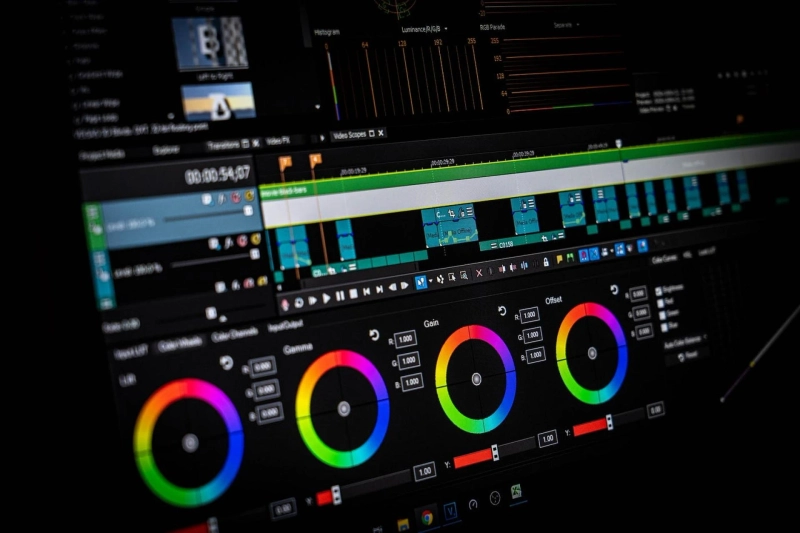Video editing takes raw footage and transforms it into a cohesive and impactful story. But the magic truly happens during color grading. This process goes beyond basic adjustments like brightness and contrast. It\'s about manipulating color to evoke emotions, establish moods, and create a visually stunning experience for viewers.In this blog will will also discuss about video editing course in Pakistan and video editing course.
Unlocking the Power of Color
Color is a powerful tool in storytelling. It can evoke a wide range of emotions, from the tranquility of a cool blue palette to the intensity of a fiery red. By mastering color grading, you can:
- Set the mood: A warm and inviting color scheme can create a sense of comfort and nostalgia, while a cool and stark palette can evoke feelings of isolation or suspense.
- Enhance the narrative: Color grading can subtly guide the viewers\' attention and emphasize important elements within the frame.
- Create a unique style: A signature color palette can become a hallmark of your work, setting you apart from other editors.
Advanced Color Grading Techniques
While basic color correction involves fixing white balance and exposure issues, advanced color grading delves deeper. Here are some key techniques to explore:
- Logarithmic color grading: Many cameras capture footage in a log format, which retains more color information. Advanced color grading software allows you to manipulate this information for greater creative control often cover working with log footage.
- Primary and secondary color correction: Primary color correction involves adjusting the overall colors in your image, while secondary color correction allows you to target specific color ranges for more precise control.
- Color wheels and curves: These tools enable you to manipulate the hue, saturation, and luminance of specific colors within your footage.
- Lift, gamma, gain: These controls offer different ways to adjust the overall tonal range of your image.
- LUTs (Look Up Tables): LUTs are presets that can be applied to your footage to achieve specific color styles. While convenient, understanding the underlying principles of color grading allows for more creative exploration.
Beyond Technical Skills: The Art of Color Grading
While technical proficiency is essential, successful color grading requires an artistic eye. Here are some tips to refine your vision:
- Develop your color vocabulary: Learn to identify and describe different color tones and their emotional impact.
- Draw inspiration from films and art: Analyze movies you admire and observe how filmmakers use color to tell their stories.
- Experiment and iterate: Don\'t be afraid to experiment with different color combinations and see what works best for your project.
- Calibrate your monitor: Ensure your monitor is properly calibrated to display colors accurately. (Video editing courses in Pakistan might cover monitor calibration techniques)
Enhancing Your Skills: Video Editing Courses in Pakistan
The world of video editing is constantly evolving, and taking a video editing course in Pakistan can equip you with the latest tools and techniques. These courses can provide a structured learning environment, offering valuable insights from experienced editors.
Here are some key factors to consider when choosing a video editing course in Pakistan:
- Course curriculum: Look for a course that covers advanced color grading techniques in detail.
- Software focus: Ensure the course covers the specific software you plan to use, such as Adobe Premiere Pro or DaVinci Resolve.
- Instructor expertise: Choose a course taught by a professional editor with experience in color grading.
- Project-based learning: Look for a course that offers hands-on experience where you can apply your learnings to real-world projects.
By investing in your education, you can elevate your skills and create videos that truly captivate your audience.
Putting It All Together: Your Color Grading Workflow
Here\'s a basic workflow for approaching color grading:
- Preparation: Organize your footage and understand the story you want to tell.
- Primary color correction: Address exposure, white balance, and overall contrast adjustments.
- Secondary color correction: Fine-tune specific colors to enhance the narrative and visual style.
- Creative grading: Apply advanced techniques and tools to create a unique visual aesthetic.
- Refine and polish: Make subtle adjustments and ensure consistency throughout your project.
Mastering the Art of Color Grading
Advanced color grading takes your video editing skills to the next level. By understanding the science behind color and developing your artistic vision, you can create captivating visuals that elevate your storytelling. Video editing course can be a valuable resource to equip you with the knowledge and tools to excel in this dynamic field.
Remember: Color grading is an iterative process. Don\'t be afraid to experiment and revisit earlier stages as your vision evolves
Conclusion
In conclusion, mastering advanced color grading techniques is essential for anyone serious about pursuing a career in video editing, especially in a dynamic and burgeoning market like Pakistan. By understanding the fundamentals of color theory and exploring advanced techniques such as LUTs, secondary color correction, and HDR grading, students in a video editing course can unlock their creative potential and produce visually stunning content that captivates audiences worldwide. So, if you\'re looking to take your video editing skills to the next level, consider enrolling in a comprehensive video editing course in Pakistan today and unleash your creative vision on the world stage.


